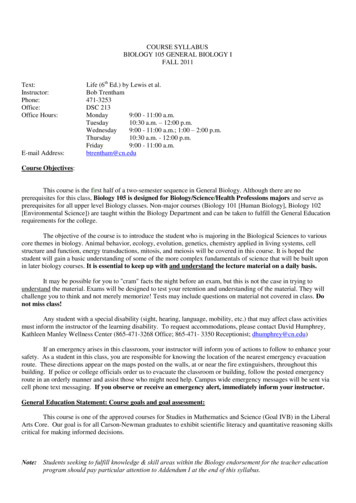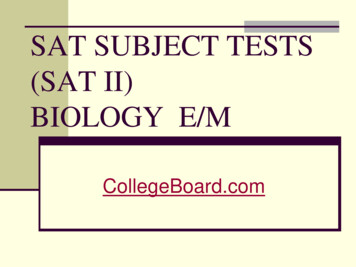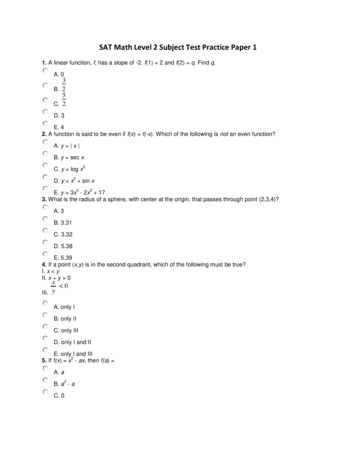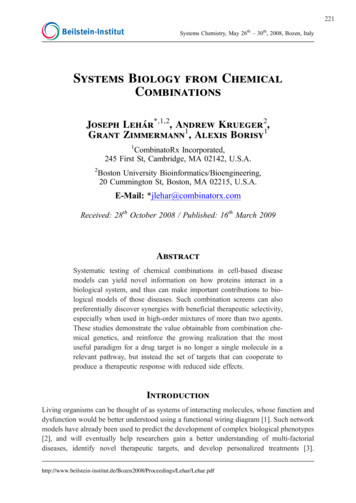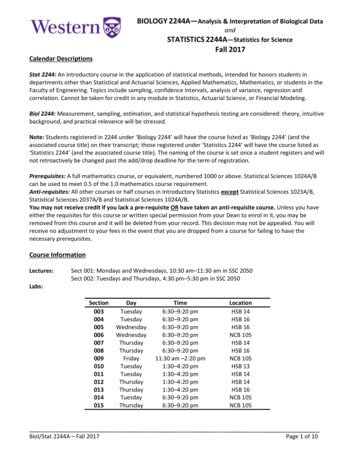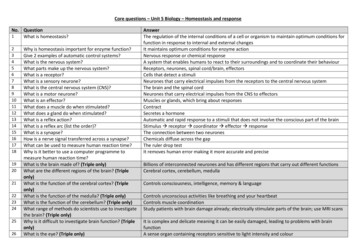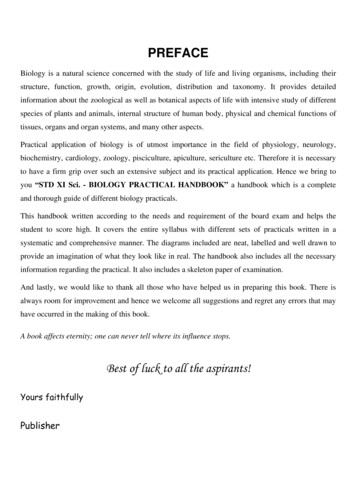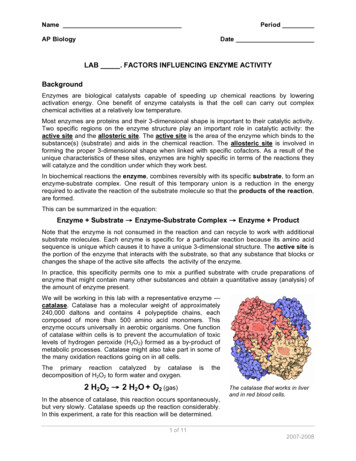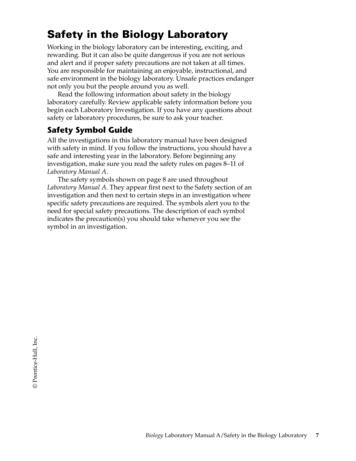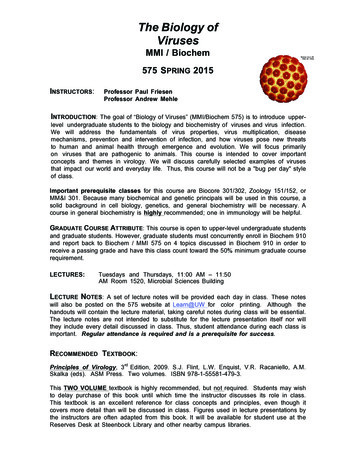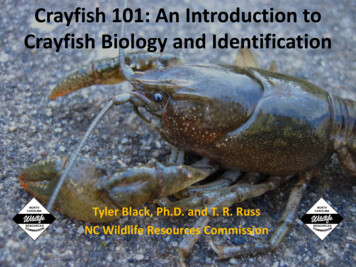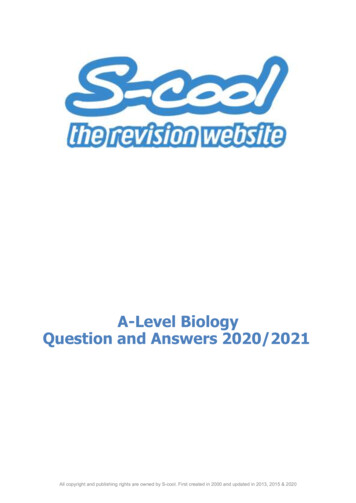
Transcription
BIOLOGY E/MSUBJECT TEST 2Your responses to the Biology E/M Subject Test 2 questions must befilled in on the Test 2 part of your answer sheet (at the back of thebook). Marks on any other section will not be counted toward yourBiology E/M Subject Test score.When your supervisor gives the signal, turn the page and begin the Biology E/M Subject Test. There are100 numbered ovals on the answer sheet. There are 60 questions in the core Biology test, 20 questionsin the Biology-E section, and 20 questions in the Biology-M section. Therefore, use only ovals 1-80 (forBiology-E) OR ovals 1-60 plus 81-100 (for Biology-M) for recording your answers.Cracking SAT Bio 23 Ch 18 1314 111612 DAS.indd 43411/16/2012 4:21:58 PM
BIOLOGY E/M SUBJECT TEST 2—ContinuedFOR BOTH BIOLOGY-E AND BIOLOGY-M,ANSWER QUESTIONS 1-60Directions: Each set of lettered choices below refers to the numbered statements immediately following it.Select the one lettered choice that BEST answers each question or BEST fits each statement, and then fill in thecorresponding oval on the answer sheet. A choice may be used once, more than once, or not at all in each set.Questions 1-4Questions cleGuard cellSweat glandDNAtRNAmRNArRNARNA polymerase1. Permits gas exchange and transpiration in leaves5. Translated to synthesize protein2. Layer that restricts evaporation in humans6. Transports amino acids during protein synthesis3. Layer that restricts evaporation in plants7. Passed on to progeny cells during cell division4. Important thermoregulatory structure inhumans8. Includes a structure known as the “anticodon”Practice SAT Biology E/M Subject Test 2Cracking SAT Bio 23 Ch 18 1314 111612 DAS.indd 435 43511/16/2012 4:21:59 PM
BIOLOGY E/M SUBJECT TEST 2—ContinuedQuestions E)Mammalia(D)PrimatesAves9. Separates animals with nails from animals withclaws10. Separates segmented worms from worms with nosegmentationBearApeHumanBird11. Separates animals with feathers from animalswith hair12. Separates animals with exoskeletons fromanimals with no exoskeletons436436 Cracking the SAT Biology E/M Subject TestCracking SAT Bio 23 Ch 18 1314 111612 DAS.indd 43611/16/2012 4:21:59 PM
BIOLOGY E/M SUBJECT TEST 2—ContinuedQuestions 13 ic competitionMutualismParasitism13. An albino plant with vascular connections to agreen plant of the same species that drains foodfrom the green plant14. Algae that grows on the shell of a turtle; the turtleis not harmed15. A tapeworm in the intestine of a human16. A population that prevents other populations fromusing a particular limited resourceDirections: Each of the questions or incomplete statements below is followed by five suggested answers orcompletions. Some questions pertain to a set that refers to a laboratory or experimental situation. For eachsituation, select the one choice that is the best answer to the question and then fill in the corresponding ovalon the answer sheet.17. Which biome contains maples, squirrels, andblack bears?(A)(B)(C)(D)(E)TundraTropical rain forestTemperate grasslandsTaigaDeciduous forest18. A man who is color blind marries a normal woman,and together they have a daughter who is notcolor blind. If the daughter marries a man withnormal vision, what is the probability of theirfirstborn child being a son who is color blind?(A)(B)(C)(D)(E)0%25%50%75%100%19. All of the following are needed for photosynthesisEXCEPT(A)(B)(C)(D)(E)20. Black coat color in horses is caused by adominant allele, while white coat color is due tothe recessive allele. Two black horses produce afoal with a white coat. If they were to produce asecond foal, what would be the probability of thesecond foal having a black coat?(A)(B)(C)(D)(E)01/41/23/4121. If one ribose molecule were bonded to oneadenine molecule and one phosphate molecule,we would have a(A)(B)(C)(D)(E)ribosomenucleotidenucleic acidATPADPlightglucosechlorophyllwatercarbon dioxidePractice SAT Biology E/M Subject Test 2Cracking SAT Bio 23 Ch 18 1314 111612 DAS.indd 437 43711/16/2012 4:21:59 PM
BIOLOGY E/M SUBJECT TEST 2—Continued22. Consider this pedigree:The allele causing the disorder (shaded individualsare affected) can best be described as(A)(B)(C)(D)(E)autosomal dominantautosomal recessiveX-linked dominantX-linked recessiveThere is not enough information to determine.23. Which of the following is/are true for a restinghuman?I. Systolic blood pressure of 180 mm HgII. Heart rate of 60–80 beats per minuteIII. Body temperature of 37oC(A)(B)(C)(D)(E)I onlyII onlyI and IIII and III onlyI, II, and III25. A community includes seven different populationswith various degrees of interbreeding. Population1 shares genes only with Population 2. Population2 shares genes only with Population 1.Population 3 has no gene flow with otherpopulations. Population 4 shares genes onlywith Population 5. Population 5 shares geneswith Population 4, Population 6, and Population7. Population 6 shares genes with Population5 and Population 7. Population 7 shares geneswith Population 5 and Population 6. Whichpopulation(s) is (are) most likely to evolve aftera change in its environment?(A)(B)(C)(D)(E)Populations 1 and 2Population 3Population 4Population 5Populations 6 and 726. Which of the following could be reasons forinfertility in a woman who is ovulating normally?I. Blocked uterine tubeII. Large amounts of FSH released justprior to ovulationIII. Large amounts of LH released just priorto ovulation(A)(B)(C)(D)(E)I onlyII onlyI and II onlyII and III onlyI, II, and III24. A researcher has a black guinea pig and wishes todetermine if it carries a recessive allele for whitehair. Both of the guinea pig’s parents are black.Which of the following would be the best methodfor the researcher to use?(A) Mate the guinea pig with another blackguinea pig and look for white offspring(B) Look for white hairs on the guinea pig(C) Mate the guinea pig with a white guinea pigand look for white offspring(D) Observe the chromosomes of a hair cell froma black hair(E) See if the guinea pig has any white siblings438438 Cracking the SAT Biology E/M Subject TestCracking SAT Bio 23 Ch 18 1314 111612 DAS.indd 43811/16/2012 4:22:00 PM
BIOLOGY E/M SUBJECT TEST 2—Continued27. What fragments would be produced if thefollowing plasmid were to be digested with EcoRIand Hind III to completion?30. Which of the following organelles would bepresent in a eukaryote but NOT in a prokaryote?I. NucleusII. MitochondriaEcoRIIII. Ribosome300 kb200 kbEcoRIHindIII400 kb75 kb(A)(B)(C)(D)(E)I onlyII onlyI and II onlyII and III onlyI, II, and IIIQuestions 31-33 refer to the following diagram of ahuman heart.PstI(A)(B)(C)(D)(E)200 kb and 300 kb200 kb, 300 kb, and 475 kb600 kb, 475 kb, 375 kb, and 500 kb200 kb, 300 kb, 400 kb, and 75 kb200 kb and 775 kb28. Human ABO blood typing is determined by theproteins present on red blood cells. The gene thatcodes for these proteins has three alleles: IA, IB,and i. IA codes for protein type A, IB codes forprotein type B, and i codes for the absence ofprotein. IA and IB are codominant and i isrecessive to both IA and IB. A woman with bloodtype A and a man with blood type AB marry andproduce children. Which of the following bloodtypes is NOT possible in their children?(A)(B)(C)(D)(E)Type AType BType OType ABAll blood types are possible in their children.29. Which organism is the LEAST closely related tothe ke12354Rightatrium7631. Which of the following represents the correctsequence of heart structures that blood wouldpass through when traveling from the right atriumto the lungs and then to the left ventricle?(A)(B)(C)(D)(E)3, 2, 4, 5, 76, 2, 1, 4, 53, 2, 1, 5, 76, 2, 3, 4, 56, 2, 4, 5, 7Practice SAT Biology E/M Subject Test 2Cracking SAT Bio 23 Ch 18 1314 111612 DAS.indd 439 43911/16/2012 4:22:00 PM
BIOLOGY E/M SUBJECT TEST 2—Continued32. Which structures carry blood rich in oxygen?(A)(B)(C)(D)(E)2, 3, 43, 5, 74, 5, 61, 5, 72, 4, 5(A)(B)(C)(D)(E)33. Which structure returns blood poor in oxygen tothe heart?(A)(B)(C)(D)(E)36. The synthesis of this molecule also results in theproduction of12345carbon dioxidewaterlipidsATPNADHQuestions 37-39 refer to the following diagram ofmarine biomes.IntertidalzoneNeriticzoneOceaniczonePhotic zoneSea levelQuestions 34-36 refer to the following diagram.HHHOHHONCCNCCOH23Marine Biomes4534. What type of molecule is depicted in the idNucleic acidStarch35. If we were to continue adding to this molecule toincrease its size, to which atom would the nextportion be bonded?(A)(B)(C)(D)(E)Abyssal zoneR2R11Aphotic zone1234510,000 m37. Which of the following is the area of leastproductivity?(A)(B)(C)(D)(E)Intertidal zoneOceanic zonePhotic zoneAphotic zoneNeritic zone38. Organisms that live in the abyssal zone wouldneed all of the following adaptations EXCEPT(A)(B)(C)(D)ability to withstand extreme pressureswell-developed eyestolerance of cold temperaturesability to survive in areas of low nutrientdensity(E) ability to utilize limited resources440440 Cracking the SAT Biology E/M Subject TestCracking SAT Bio 23 Ch 18 1314 111612 DAS.indd 44011/16/2012 4:22:01 PM
BIOLOGY E/M SUBJECT TEST 2—Continued39. Organisms that live in the intertidal zone mighthave which of the following characteristics?I. Ability to conduct photosynthesisII. Tolerance of periodic droughtIII. Tolerance of a wide range of temperatures(A)(B)(C)(D)(E)I onlyII onlyI and III onlyII and III onlyI, II, and IIIBecause some fruits contain enzymes that act asproteases, various fruit extracts were tested for use aspossible meat tenderizers. The extracts were testedover a range of pH values. Below is a graph of relativeeffectiveness (compared to distilled water) vs. ared 6to Distilled 4Water)2AppleBanana246810 1214pH40. Which fruit extract operates over the broadest apayaPineappleApple43. What does it mean when a fruit extract has arelative effectiveness of 1 ?Questions 40-431042. Which fruit extract is most effective at a neutral t is 100% more effective than water.It is 10% as effective as water.It is 1% as effective as water.It is equally as effective as water.It is equally concentrated as water.Questions 44 -47A self-pollinating plant with orange flowers andalternating leaf arrangement produces 47 plants withred flowers and alternating leaves, 103 plants withorange flowers and alternating leaves, and 51 plantswith yellow flowers and alternating leaves.44. The allele for yellow flower color is(A)(B)(C)(D)(E)recessivedominantincompletely dominantincompletely recessivecodominant45. If a yellow-flowered offspring wereself-pollinated, what would the resulting plants’flowers look like?(A)(B)(C)(D)(E)100% yellow100% red100% orange50% yellow, 50% red75% red, 25% yellow41. Over which pH range does pineapple extractoperate at no less than 50% of its maximumeffectiveness?(A)(B)(C)(D)(E)pH 4 to pH 10pH 2 to pH 12pH 6 to pH 8pH 7 to pH 11pH 10 to pH 14Practice SAT Biology E/M Subject Test 2Cracking SAT Bio 23 Ch 18 1314 111612 DAS.indd 441 4 4111/16/2012 4:22:01 PM
BIOLOGY E/M SUBJECT TEST 2—Continued46. The genotype of the original parent plant is(A) heterozygous for both flower color and leafarrangement(B) homozygous for both flower color and leafarrangement(C) homozygous for flower color andheterozygous for leaf arrangement(D) heterozygous for flower color andhomozygous for leaf arrangement(E) heterozygous for flower color but unable todetermine genotype for leaf arrangement47. Suppose the original parent plant is crosspollinated with a plant that has red flowers andnon-alternating leaves. All of the resultingoffspring have non-alternating leaves. Which ofthe following is/are true?I. None of the offspring have orangeflowers.II. The allele for alternating leaves isrecessive.III. Approximately half of the offspringhave red flowers.(A)(B)(C)(D)(E)I onlyII onlyIII onlyI and III onlyII and III onlyQuestions 48-502-butoxyethanol, a substance found in a generalhousehold cleaner, was tested for toxicity to termites.Solutions were made that contained various parts permillion (PPM) of 2-butoxyethanol, and 15 mL of eachof these diluted solutions was mixed with 150 g ofwood chips. Twenty mature termites were added to thewood chips, and the number surviving after 24 hourswas determined and recorded. The following graphpresents the results.Number ofsurvivingtermites1614121086421520 253035PPM of 2-butoxyethanol48. At which dose does 50% of the termitepopulation survive?(A)(B)(C)(D)(E)15 PPM20 PPM25 PPM30 PPM35 PPM49. How is this substance toxic to termites?(A) It paralyzes their jaws so they are unableto eat.(B) It prevents digestion of wood.(C) It kills the microorganisms in thetermites’ digestive tracks that digestwood.(D) At 40 PPM only 20% of the termitessurvive.(E) There is no information given thatdescribes the mechanism of toxicity.50. Based on the data for 20 PPM 2-butoxyethanol,what concentration of solution would berequired to kill the entire 20-member termitepopulation?(A)(B)(C)(D)(E)40 PPM50 PPM60 PPM70 PPM80 PPM442442 Cracking the SAT Biology E/M Subject TestCracking SAT Bio 23 Ch 18 1314 111612 DAS.indd 44211/16/2012 4:22:02 PM
BIOLOGY E/M SUBJECT TEST 2—ContinuedQuestions 51-54The following experiment was performed to test the effect of an auxin on plant growth. The auxin wasdissolved in a gelatin block; gelatin does not affect the biological activity of the auxin. Several plant seedlingswere prepared as described below and growth was measured every five days.AUXINPLANT 1not cutnothing appliedPLANT 2tip removednothing appliedPlant12345PLANT 3tip removedgelatin alone appliedto cut edgeGrowth after 5 days15 mm4 mm5 mm14 mm8 mm51. Based on the results of the experiment, one canconclude that the tip of the plant ng significantPLANT 4tip removedgelatin auxin appliedto cut edgePLANT 5tip removedgelatin auxin appliedas a paste to leafGrowth after 10 days29 mm9 mm10 mm31 mm20 mm52. Which of the following plants in the experimentacted as a control?I. Plant 1II. Plants 2 and 3III. Plant 5(A)(B)(C)(D)(E)I onlyII onlyIII onlyI and II onlyI, II, and IIIPractice SAT Biology E/M Subject Test 2Cracking SAT Bio 23 Ch 18 1314 111612 DAS.indd 443 44311/16/2012 4:22:02 PM
BIOLOGY E/M SUBJECT TEST 2—Continued53. What proves that auxin is necessary for plantgrowth?(A)(B)(C)(D)(E)54. In a separate experiment, an auxin/gelatin blockapplied to only half the cut edge of the tip causedthe plant to grow and bend in the oppositedirection. For example, if the auxin/gelatin blockwas applied to the left side of the cut edge, theplant grew and bent toward the right. Which ofthe following is the most likely explanation forthis observation?Plant 1 grew faster than Plants 2 or 3.Plant 4 grew faster than Plants 2 or 3.Plant 5 grew faster than Plant 1.Plant 3 grew faster than Plant 2.Plant 4 grew faster than Plant 5.(A) Sunlight caused the plant to bend.(B) The plant exhibited gravitropism.(C) Auxin stimulated cell division on theopposite side of the plant.(D) Auxin stimulated cell division on the sameside of the plant.(E) Auxin stimulated cell growth toward a lightsource.Questions 55-58 refer to the following experiment performed on frog oocytes.Unfertilized frog oocytes were bathed in a neutral, isotonic solution (Frog Ringer’s solution) to prevent changes involume due to osmosis. The Frog Ringer’s solution was supplemented with radiolabeled amino acids. A sampleof oocytes was taken every 30 minutes and assayed for radioactivity.At Time 1, the oocytes were fertilized. Samples were taken at five-minute intervals after fertilization and assayedfor radioactivity. The results are presented in the graph below.120Counts per minute(cpm), 560Time in minutesTime 1444444 Cracking the SAT Biology E/M Subject TestCracking SAT Bio 23 Ch 18 1314 111612 DAS.indd 44411/16/2012 4:22:02 PM
BIOLOGY E/M SUBJECT TEST 2—Continued55. The radioactivity measured after fertilization wastaken up by(A)(B)(C)(D)(E)being incorporated into DNAbeing incorporated into proteinsattaching to the cell membraneendocytosisassociating with carbohydrates56. How could a control be created for this experiment?(A) Immerse the oocytes in non-radiolabeledFrog Ringer’s solution prior to fertilization(B) Sample the oocytes at five–minute intervalsprior to fertilization(C) Sample the oocytes at 30–minute intervalsafter fertilization(D) Divide the oocytes into two groups,immerse one group in non-radiolabeledFrog Ringer’s solution and one group inradiolabeled solution(E) Divide the oocytes into two groups, fertilizeone group, and simulate fertilization in theother, but do not actually introduce sperminto the oocytes57. Based on the results of the experiment, theprocess most likely occurring after fertilization is(A)(B)(C)(D)(E)DNA replicationorganogenesisprotein synthesisRNA transcriptionendocytosisQuestions 59-60A group of 10 newly hatched chicks was separatedinto two smaller groups containing five chicks each.One group (Group A) was left with the mother hen,the other group (Group B) was taken shortly afterhatching and kept with a mother goose. The chicks inGroup A displayed normal behavior and followed themother hen around. The chicks in Group B followedthe mother goose around and exhibited goose likebehavior, such as swimming. After one week, GroupB was reunited with the mother hen, but ignored her,and instead continued to follow the mother goosearound the barnyard.59. The behavior exhibited by the chicks in Group B ionconditioning60. If exposed to a mother pig during the periodshortly after hatching, the chicks in Group Bwould exhibit(A)(B)(C)(D)(E)pig like behaviorgoose like behaviorchick like behaviorunique behaviorunknown behavior58. The Frog Ringer’s solution in the experiment isdescribed as being isotonic. An isotonic solution(A)(B)(C)(D)(E)has more DNA than another solutionhas more protein than another solutionis more concentrated than another solutionis less concentrated than another solutionis equally concentrated to another solutionIf you are taking the Biology-E test, continue with questions 61-80.If you are taking the Biology-M test, go to question 81 now.Practice SAT Biology E/M Subject Test 2Cracking SAT Bio 23 Ch 18 1314 111612 DAS.indd 445 44511/16/2012 4:22:03 PM
BIOLOGY-E TEST 2Directions: Each of the questions or incomplete statements below is followed by five suggested answers orcompletions. Some questions pertain to a set that refers to a laboratory or experimental situation. For eachquestion, select the one choice that is the best answer to the question and then fill in the corresponding ovalon the answer sheet.61. Which of the following organisms is able toregulate its own body tle62. A virus is considered a parasite because itI. harms its hostII. kills its hostIII. cannot reproduce outside its host(A)(B)(C)(D)(E)I onlyII onlyI and III onlyII and III onlyI, II, and III63. An organism that feeds at several trophic levels is(A)(B)(C)(D)(E)a carnivorean omnivorea primary consumeran herbivorea primary producer64. Yeast are cultured in a flask of nutrient brothunder anaerobic conditions. The yeast that aremost fit are those that(A)(B)(C)(D)(E)446 ferment the fastestconsume less of the limited oxygen supplysurvive the longestproduce the most ATPproduce the most buds65. A mushroom is most like a(A)(B)(C)(D)(E)mossfernyeastpineseaweed66. In a certain ecosystem, the primary producersrepresent 100,000 kcal of energy. Assuming a10% transfer of energy between trophic levels,how much energy is available to the fourthtrophic level?(A)10 kcal(B)100 kcal(C)1,000 kcal(D) 10,000 kcal(E) 100,000 kcal67. Which of the following represents the properecological hierarchy?(A) Population community ecosystem biosphere(B) Ecosystem community population biosphere(C) Population ecosystem community biosphere(D) Biosphere ecosystem population community(E) Community population biosphere ecosystemCracking the SAT Biology E/M Subject TestCracking SAT Bio 23 Ch 18 1314 111612 DAS.indd 44611/16/2012 4:22:03 PM
BIOLOGY-E TEST 2—ContinuedQuestions 68-69The following data table shows the number of differentamino acids in the beta hemoglobin chain of variousorganisms compared to the human beta chain.OrganismNumber of different amino 1112535269. Human hemoglobin and gorilla hemoglobin areeven more closely related than the organismsshown in the table; they differ by only a singleamino acid. Yet humans and gorillas are consideredto be separate species. This is because(A) their hemoglobin chains differ by a singleamino acid(B) human hemoglobin and gorilla hemoglobinhave different functions(C) they are unable to interbreed(D) they are the result of convergent evolution(E) they are the result of parallel evolution68. To which of the following organisms are humansmost closely related, based on hemoglobin aminoacid mpreyPractice SAT Biology E/M Subject Test 2Cracking SAT Bio 23 Ch 18 1314 111612 DAS.indd 447 44711/16/2012 4:22:03 PM
BIOLOGY-E TEST 2—ContinuedQuestions 70 -71 refer to the diagram below.Nitrogen Cycle448 Cracking the SAT Biology E/M Subject TestCracking SAT Bio 23 Ch 18 1314 111612 DAS.indd 44811/16/2012 4:22:03 PM
BIOLOGY-E TEST 2—Continued70. Can both animals and plants obtain their nitrogenfrom the atmosphere?(A) Yes, both animals and plants take in nitrogenduring respiration.(B) Yes, most of the nitrogen in the cycle is inthe atmosphere.(C) No, only plants can take in nitrogen from theatmosphere.(D) No, they must consume it through eating oruptake from the soil.(E) No, they must obtain it through symbioticrelationships.71. Bacteria in the soil are(A)(B)(C)(D)(E)primary producersprimary consumerssecondary consumerstertiary consumersdecomposers73. All of the structures are the result of(A)(B)(C)(D)(E)mutationsuccessionconvergent evolutiondivergent evolutionregressionQuestions 74 -75 refer to the following diagrams.1Homo sapiens(modern fricanus4Pan troglodytes(modern chimpanzee)Questions 72-73 refer to the following structures.74. Based on physical similarity, which skulls appearto be most closely related?123(A)(B)(C)(D)(E)1 and 21 and 32 and 32 and 41 and 475. What is the most advantageous differencebetween the ancestral primate skulls and themodern human skull?4572. Which of these structures would be used facing eyesIncreased brain capacityLoss of canine teethLoss of brow ridgeReduction in jaw size12345Practice SAT Biology E/M Subject Test 2Cracking SAT Bio 23 Ch 18 1314 111612 DAS.indd 449 44911/16/2012 4:22:04 PM
BIOLOGY-E TEST 2—ContinuedQuestions 76 -77Six pairs of bald eagles were released into the wildin Indiana. Four of the pairs of birds successfullynested and raised young. Two of the pairs nested nearan industrial complex that released waste products(PCBs) into a nearby lake. These birds laid eggs, butthe embryos failed to develop.Questions 78-80 refer to the following dataobtained for a rabbit population over a periodof several years.Year123476. Which of the following is the LEAST likelyreason for the failure of the embryos to develop?(A) Mutations in the embryos halted theirdevelopment.(B) The adult birds failed to exhibit propernesting behavior and did not care for theeggs.(C) The contaminated lake water that the birdsconsumed affected the development oftheir young.(D) The sperm of the males were affected by thePCBs in such a way that they were unableto fertilize the eggs.(E) Indiana is not a good location for bald eaglesto mate and reproduce.77. The eggshells of the embryos that failed todevelop were tested and were found to containmore PCBs than the nearby plants and insects.This is due to(A)(B)(C)(D)(E)450 biomagnificationincreased levels of PCBs in the lakethe resistance of the insects to PCBsfailure of the plants to take up PCBsabsorption of PCBs from the nesting siteinto the eggshellNumber of rabbits4176224578. Which of the following graphs best represents thedata on rabbit population onsizeYearCracking the SAT Biology E/M Subject TestCracking SAT Bio 23 Ch 18 1314 111612 DAS.indd 45011/16/2012 4:22:05 PM
BIOLOGY-E TEST 2—Continued79. Assuming unlimited resources, what would be theapproximate expected rabbit population in Year 5 ?(A) 5,000(B) 1,000(C) 500(D) 300(E) 10080. Ultimately, the amount of nutrients and otherresources would become limiting. What wouldhappen to the rabbit population at that time?I. It would reach the carrying capacity ofthe environment.II. It would continue to grow indefinitely.III. It would engage in intraspecificcompetition.(A)(B)(C)(D)(E)I onlyII onlyI and II onlyI and III onlyI, II, and IIISTOPIF YOU FINISH BEFORE TIME IS CALLED, YOU MAY CHECK YOURWORK ON THE ENTIRE BIOLOGY-E TEST.Practice SAT Biology E/M Subject Test 2Cracking SAT Bio 23 Ch 18 1314 111612 DAS.indd 451 45111/16/2012 4:22:05 PM
BIOLOGY-M TEST 2If you are taking the Biology-M test, continue with questions 81-100.Be sure to start this section of the test by filling in oval 81 on your answer sheet.Directions: Each of the questions or incomplete statements below is followed by five suggested answers orcompletions. Some questions pertain to a set that refers to a laboratory or experimental situation. For eachquestion, select the one choice that is the best answer to the question and then fill in the corresponding ovalon the answer sheet.85. A buck with a large, impressive rack of antlerssires four offspring, three males and one female.The three male offspring also have large, impressive(A) Remain unchangedantlers, but before being able to reproduce, two(B) Swell and burstof the male offspring get their antlers tangled in(C) Shrivela low-hanging tree and are caught and killed by(D) Swell and dividewolves. A second buck with a smaller set of(E) Release solute by exocytosisantlers sires three male offspring; all of thesemales have smaller antlers like their father. They82. When during cell division do chromosomes move toare more effective at escaping predators andopposite poles of the cell?successfully reproduce. In terms of evolution,which of the original bucks is more fit?(A) When the centrioles replicate(B) After the nuclear membrane disintegrates(A) The buck with the larger antlers because he(C) Immediately following DNA replicationsired more offspring.(D) When the DNA condenses(B) The buck with the smaller antlers because(E) Immediately after the centromere splitsmore of his offspring survived.(C) The buck with the larger antlers because hewill be more successful at attracting a83. Convergent evolution can result in all of the followingmate and continuing to reproduce.EXCEPT(D) The buck with the smaller antlers because he(A) structures that have similar functionsis more effective at escaping predators and(B) behaviors that are similarwill continue to reproduce.(C) different species that resemble one another(E) Both bucks are equally fit.(D) production of a single species from twooriginally different species(E) niches that are similar81. An animal cell placed into a 0.9% solute solutionwould do which of the following?84. What structure is common to ALL cell types?(A)(B)(C)(D)(E)ChloroplastPlasma membraneCell wallMitochondriaFlagella452452 Cracking the SAT Biology E/M Subject TestCracking SAT Bio 23 Ch 18 1314 111612 DAS.indd 45211/16/2012 4:22:05 PM
BIOLOGY-M TEST 2—ContinuedQuestions 86 -89 refer to the following experiment.A population of ampicillin-resistant bacteria (Strain 1)is grown in a laboratory and is infected with a virus.The bacterial population begins to decline as the virusinitially goes through the lytic cycle, then rebounds asthe virus integrates into the bacterial chromosome tobegin the lysogenic cycle.The bacteria reproduce normally until they areheat-shocked. The rapid increase in temperaturecauses the virus to remove itself from the bacterialgenome and enter the lytic cycle. Within several hoursall bacteria are dead and a free virus is found in highconcentration in the bacterial growth medium.This free virus is used to infect a population ofbacteria that is sensitive to ampicillin (Strain 2). Afterthe expected decrease and rebound of this bacterialpopulation (as above), the rebounded population wasfound to be ampicillin-resistant.86. Evolution of a bacterial population occurs muchmore rapidly than evolution of a human population.This is because88. The bacterial culture is constantly infused withoxygen to ensure a high rate of reproductionamong the bacteria and a healthy population.One evening the oxygen delivery system getsclogged and the bacteria receive no oxygen, yetthey survive and continue to reproduce, just at aslower rate. These bacteria can be classified as(A)(B)(C)(D)(E)obligate aerobesobligate anaerobestolerant anaerobesfacultative anaerobessimple anaerobes89. Which of the following increase genetic diversityin bacteria?I. ConjugationII. TransformationIII. Crossing over(A)(B)(C)(D)(E)I onlyI and II onlyIII onlyII and III onlyI, II, and III(A) the bacteria are smaller and thus moresusceptible to change(B) the bacterial life cycle is short and many newgenerations can be produced quickly(C) humans do not evolve(D) humans c
Practice SAT Biology E/M Subject Test 2 4 35 BIOLOGY E/M SUBJECT TEST 2—Continued FOR BOTH BIOLOGY-E AND BIOLOGY-M, ANSWER QUESTIONS 1-60 Directions: Each set of lettered choices below refers to the numbered statements immediately following it. Select the one lettered choice that BEST answers each q
